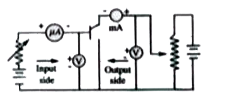Draw the circuit symbols for p-np and n-p-n transistors.
To draw the circuit symbols for PNP and NPN transistors, follow these steps:
Step 1: Draw the PNP Transistor Symbol
1. Start by drawing a circle to represent the transistor.
2. Inside the circle, draw three lines that represent the three terminals of the transistor:
- The top line represents the Emitter (E), which is of P-type material.
- The middle line represents the Base (B), which is of N-type material.
- The bottom line represents the Collector (C), which is also of P-type material.
3. Label the terminals appropriately:
- Label the top terminal as E (Emitter).
- Label the middle terminal as B (Base).
- Label the bottom terminal as C (Collector).
Step 2: Draw the NPN Transistor Symbol
1. Again, start with a circle to represent the transistor.
2. Inside the circle, draw three lines for the terminals:
- The top line represents the Collector (C), which is of N-type material.
- The middle line represents the Base (B), which is of P-type material.
- The bottom line represents the Emitter (E), which is of N-type material.
3. Label the terminals appropriately:
- Label the top terminal as C (Collector).
- Label the middle terminal as B (Base).
- Label the bottom terminal as E (Emitter).
Final Diagrams
- The PNP transistor symbol will have the emitter and collector as P-type materials at the top and bottom, respectively, with the base in the middle as N-type.
- The NPN transistor symbol will have the collector and emitter as N-type materials at the top and bottom, respectively, with the base in the middle as P-type.
1. Start by drawing a circle to represent the transistor.
2. Inside the circle, draw three lines that represent the three terminals of the transistor:
- The top line represents the Emitter (E), which is of P-type material.
- The middle line represents the Base (B), which is of N-type material.
- The bottom line represents the Collector (C), which is also of P-type material.
3. Label the terminals appropriately:
- Label the top terminal as E (Emitter).
- Label the middle terminal as B (Base).
- Label the bottom terminal as C (Collector).
1. Again, start with a circle to represent the transistor.
2. Inside the circle, draw three lines for the terminals:
- The top line represents the Collector (C), which is of N-type material.
- The middle line represents the Base (B), which is of P-type material.
- The bottom line represents the Emitter (E), which is of N-type material.
3. Label the terminals appropriately:
- Label the top terminal as C (Collector).
- Label the middle terminal as B (Base).
- Label the bottom terminal as E (Emitter).
- The PNP transistor symbol will have the emitter and collector as P-type materials at the top and bottom, respectively, with the base in the middle as N-type.
- The NPN transistor symbol will have the collector and emitter as N-type materials at the top and bottom, respectively, with the base in the middle as P-type.
Topper's Solved these Questions
- SEMICONDUCTOR DEVICESBOOK - AAKASH SERIESCHAPTER - SEMICONDUCTOR DEVICESEXERCISE - Problems (LEVEL-I)
35 Videos
- SEMICONDUCTOR DEVICESBOOK - AAKASH SERIESCHAPTER - SEMICONDUCTOR DEVICESEXERCISE - Problems (LEVEL-II)
9 Videos
- SEMICONDUCTOR DEVICESBOOK - AAKASH SERIESCHAPTER - SEMICONDUCTOR DEVICESEXERCISE - Exercise (Short answer questions)
27 Videos
- RAY OPTICSBOOK - AAKASH SERIESCHAPTER - RAY OPTICSEXERCISE - PROBLEMS ( LEVEL-II)
60 Videos
- UNITS AND MEASUREMENTBOOK - AAKASH SERIESCHAPTER - UNITS AND MEASUREMENTEXERCISE - PRACTICE EXERCISE
45 Videos
Similar Questions
Draw the circuit symbol of photodiode.
View SolutionThe symbol of p-n-p transistor is
View Solution(a) Draw the circuit arrangement for studying the input and output characteristics of an n-p-n transistor in CE configuration . With the help of these characteristics define (i) input resistance , (ii) current amplification factor .
(b) Describe briefly with the help of a circuit diagram how an n-p-n transistor is used to produce self-sustained oscillations .
View Solution(i) Draw a circuit diagram to study the input and output characteristics of an n-p-n transistor in its common emitter configuration. Draw the typical input and output characteristics.
(ii) Explain, with the hepl of a circuit diagram, the working of n-p-n transistor as a common emitter amplifier.
View SolutionIn a common emitter amplifier circuit using an n-p-n transistor, the phase difference between the input and the output voltages will be:-
View SolutionThe number of terminals in n−p−n transistor is
View SolutionThe circuit diagram below shows n-p-n transistor in CE configuration. For this configuration, mark the correct statement(s).

View SolutionGive a circuit diagram of a common emitter amplifier using an n-p-n transistor. Draw the input and output wavefroms of the signal. Write the expression for its voltage gain.
View SolutionDraw the diagram of the circuit arangement used for studying the 'input' and the 'output' characteristics of an n-p-n transistor inits CE configuration. Briefly explain how these two types of characteristics are obtained and draw these characteristics.
(b) 'Define' the terms (i) Input resistance, (ii) Output resistance , (iii) Current amplification factor, for a given transistor.
View SolutionDraw typical output characteristics of an n-p-n transistor in CE configuration. Show how these characteristics can be used to determine output resistance.
View Solution
